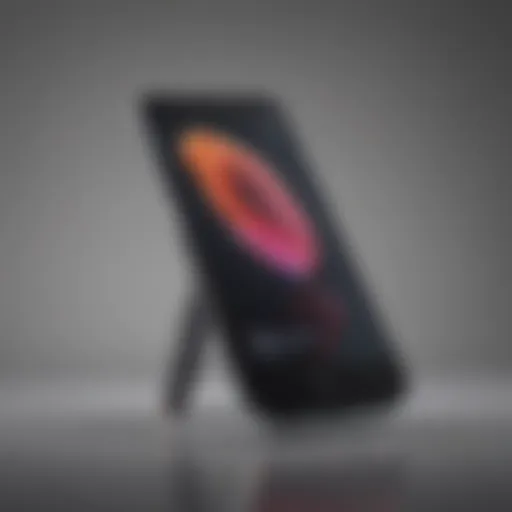Anticipating the Next Generation of Apple Watch
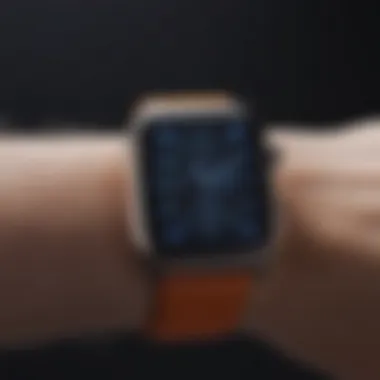

Intro
The Apple Watch has made quite a name for itself, becoming a staple in the wearable tech world. As the next iteration approaches its anticipated release, it's no wonder that whispers and speculations are swirling like leaves in the wind. This article will take a closer look at what's cooking in Apple's labs, examining expected features, release timelines, and the interplay between consumer expectations and market trends. With each new model, Apple not only enhances its ecosystem but also reshapes the expectations of its staunch fanbase.
Product Overview
As we gear up for the release of the upcoming Apple Watch, it's crucial to understand just what has made the Apple Watch such a formidable contender in the smartwatch arena. Apple has consistently produced devices that not only showcase cutting-edge technology but also integrate beautifully into daily life.
- Key Features and Specifications: This new model is rumored to come equipped with advanced health monitoring capabilities, a more powerful processor, and possibly even satellite connectivity for emergency communications. Expect improvements in battery longevity as well; users just want to forget about charging their devices daily.
- Available Variants/Colors: While Apple has kept their cards close to their chest regarding available colors and styles, industry buzz suggests a fresh palette, possibly revisiting some fan-favorite hues alongside new materials that appeal to a broader audience.
Design and Build Quality
When it comes to design, the Apple Watch has always struck a balance between functionality and aesthetics. The next version is likely to build upon this foundation with a sleeker profile and rugged construction suitable for a variety of lifestyles.
- Visual Description: Imagine a device that seamlessly melds professional polish with athletic flair. You could expect customizable watch faces, adaptable straps, and an overall look that feels both modern and timeless.
- Materials: Rumored to use both aluminum and perhaps stainless steel, it’s likely that there will be new materials introduced too, such as titanium for those looking for something more robust.
- Ergonomics: Previous models have generally received high marks for comfort, especially during long wear. Expect no less from this new release, with adjustments aimed at making it less obtrusive.
Performance and User Experience
The Apple Watch continues to evolve, and its performance certainly does not lag behind. The heart of any gadget is its processor, and this future model is likely to feature a chip that provides faster processing speeds, ensuring a buttery-smooth user experience.
- Processor Details: Speculation suggests an upgrade to the current S chip used, resulting in quicker app launches and more efficient operation. The faster the processor, the less time users spend waiting, which is always a good thing.
- User Interface: Expect refinements to watchOS that enhance usability, with easier navigation via gesture controls and potentially new app features that complement daily routines.
- Multitasking Capabilities: Allowing the user to toggle between fitness stats, notifications, and music might see improvements that slant toward multitasking without a hitch, becoming increasingly central to user interaction.
Pricing and Availability
One area where Apple often captures attention is in its pricing strategy. The new Apple Watch will likely follow suit, with multiple pricing tiers aimed at different segments of the market.
- Pricing Options: Depending on the configuration you fancy, various price points will cater to both premium users and those just stepping into the world of wearables.
- Availability: As always, Apple will ensure that their flagship product is available worldwide, though initial supply might be more limited in certain regions due to a buzz of anticipation.
- Valuation Against Competitors: Many potential customers will look at choices from Garmin or Samsung. The Apple Watch tends to remain in a league of its own when assessing value based on ecosystem integration and brand loyalty.
"Each new model of the Apple Watch doesn't just add features; it raises the bar for what users expect from wearable technology."
Understanding Apple's Release Cycle
Grasping Apple's release cycle is more than just a casual interest; it is crucial for anyone who wishes to keep their fingers on the pulse of cutting-edge technology and consumer electronics. Apple, known for its innovative approach, follows a fairly predictable timeline when it comes to launching new products. Understanding this rhythm can empower enthusiasts and buyers alike to anticipate new features and innovations, ensuring they are informed when the time comes to purchase.
When people talk about Apple’s releases, it’s not only about the excitement of a new product hitting the shelves. It’s also about understanding how Apple strategically positions its products in the market. The release cycle reflects the company’s broader marketing strategies, brand positioning, and, of course, consumer demand. The carefully orchestrated events and announcements are pivotal, as they create anticipation that permeates the tech community.
Historical Context of Releases
To better comprehend where we are today, one must take a glance back through Apple’s history. Significant landmarks in the company’s release cycle include the debut of the first Apple Watch in April 2015, which set the stage for the company’s foray into wearable technology. Subsequent and regular updates—such as the Series 2, Series 3, and so forth—have not only introduced new features but also refined the existing ones that customers cherished. Each yearly release tends to build on the last, both technologically and in terms of consumer expectations.
These releases generally happen in September, when Apple unrolls a host of updates across various product lines, particularly, the iPhone and the Apple Watch. This has created a pattern that allows both Apple and its consumers to prepare accordingly. A related aspect to note is that Apple's decision-making on when to release can be influenced by their competitors’ timelines as well. If a rival brand launches a significant product, Apple may adjust its own schedule to maintain its competitive edge.
Factors Influencing Release Dates
Several elements play a significant role in determining when Apple decides to release its newest smartwatch.
- Technological Readiness: Ensuring that all technological aspects are up to par is paramount. Apple is known for its high standards, and rushed products are not a part of its strategy. Testing and reliability are vital for the company’s reputation, leading to potential delays if issues arise.
- Market Trends: Another factor is how the market is evolving. If research indicates a growing interest in certain features, Apple may prioritize those for upcoming releases. For example, health and fitness functionalities have seen increased consumer interest, prompting more advanced tracking systems in recent iterations.
- Supply Chain Considerations: The sourcing and availability of key components can also dictate release dates. Unforeseen interruptions—such as global supply disruptions—can lead to postponements.
- Strategic Timelines: Lastly, Apple employs strategic maneuvering against competitors. The company frequently analyzes competitor launches to optimize its own product timing. For instance, observing a successful launch from Fitbit or Samsung could steer Apple's decisions on when to unveil its latest watch.
"Understanding the intricacies of Apple's release cycle offers insight into not just the development of new products, but also the company’s response to global tech trends and consumer needs."
In summary, knowing the historical context and the various factors impacting release dates makes it easier to anticipate future developments with Apple’s watch releases. For both tech enthusiasts and potential buyers, staying educated on these elements provides a significant advantage, as the next product launch is just around the corner.
Current Trends in Smartwatch Technology
In the rapidly evolving landscape of wearable technology, the role of smartwatches has extended far beyond mere timekeeping. As we look towards the anticipated release of the next Apple Watch, it's important to examine current trends that dictate innovation and user preferences in this domain. These trends reflect not just technological advancements but also shifting consumer expectations and habits. Understanding these elements can provide valuable insights for potential buyers, ensuring they make informed decisions when this hotly awaited gadget finally hits the market.
Innovation in Wearable Devices
The phrase "wearable technology" encompasses a diverse range of devices, yet smartwatches have positioned themselves as frontrunners in this sector. One key factor behind their increasing popularity is the integration of innovative features that cater to health, connectivity, and personalization.
Many recent models have made substantial leaps in the realm of health monitoring. For instance, features such as electrocardiogram (ECG) capabilities and blood oxygen level tracking are becoming standard rather than exceptional. Consumers are now more health-conscious than ever, often using their smartwatches as vital health tools, tracking metrics that inform their daily lifestyle choices. This trend not only highlights advances in sensor technology but also subtly nudges individuals towards more proactive approaches to their well-being.
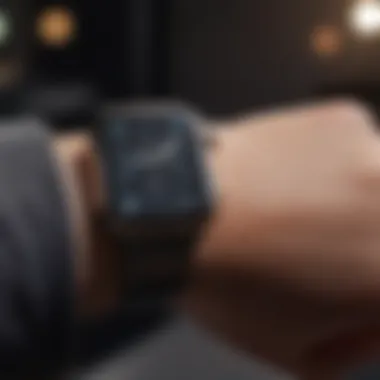

Moreover, user interface design is another noteworthy innovation. Recent smartwatches boast sleek designs and intuitive interfaces, such as gesture controls and customizable watch faces, allowing users to tailor their experience. This kind of functionality encourages deeper engagement, inviting users to explore features they might not have considered otherwise. With convenience at the forefront, schedules can be managed and meaningful notifications received without the need to constantly check a smartphone.
Consumer Expectations and Demands
As smartwatches gain traction among various demographics, consumer expectations are shaping their development in substantial ways. Today's users demand more than just basic functionalities; they seek devices that seamlessly blend into their lifestyles.
When discussing expectations, it's important to note the significance of compatibility. Users frequently desire watches that can easily synchronize with their existing devices, particularly for those already entrenched in the Apple ecosystem. They want a fluid experience where switching between their Apple Watch, iPhone, and other connected devices feels effortless.
Furthermore, aesthetics play a critical role in purchasing decisions. Consumers today aren't just looking for functionality; they want style, too. This creates a challenging but exciting environment for brands to push design boundaries, leading to colorful bands, unique materials, and customizable features that reflect personal style.
"In the end, it's the user experience that dictates what kind of smartwatch ends up on our wrists."
Additionally, sustainability has entered the conversation. A growing segment of consumers expresses interest in eco-friendly materials and ethical practices in manufacturing. Thus, companies are under pressure to not just innovate but to consider the broader implications of their products on the planet.
By keeping a pulse on these trends, Apple and its competitors are working to meet and exceed the high expectations of their customer base, further entrenching wearable devices in everyday life. Thus, as we await the next iteration of the Apple Watch, it will be interesting to see how these trends continue to shape its features and functionality.
Predicted Features of the Upcoming Apple Watch
As anticipation builds ahead of the next Apple Watch release, the discussion around its predicted features takes on critical significance. At the heart of this expectation is the desire for innovation—something Apple is known for, yet also held to high standards by its loyal customer base. By exploring the expected advancements and features, we can gain a clearer picture of how these innovations will elevate the user experience, continuing to place the Apple Watch ahead of the curve in the competitive world of wearable technology.
Health Monitoring Advancements
Health monitoring has always been a key selling point for the Apple Watch, and the upcoming model promises to enhance this aspect significantly. Users currently benefit from features like heart rate monitoring, ECG readings, and even blood oxygen level assessments. However, many industry insiders believe that Apple is gearing up to introduce more sophisticated metrics, such as real-time blood glucose monitoring or enhanced sleep tracking.
These innovations aren't just bells and whistles; they are potentially life-changing for many users. Imagine diabetics getting real-time feedback without constant finger pricks or sleep enthusiasts understanding their sleep cycles in greater detail. It’s not merely about keeping up with competitors; it’s about defining new industry standards.
Battery Life Enhancements
When it comes to battery life, this has often been the Achilles' heel of many smartwatches, including Apple’s own devices. As more functionalities are packed into these gadgets, the demand for a longer-lasting battery becomes paramount. Apple is rumored to be working on improvements that could allow the new watch to sustain two days of standard use without needing a charge. This would mean fewer interruptions for users and a more seamless experience, particularly for health-focused applications that rely on continuous monitoring.
A robust battery life not only enhances user satisfaction but can also play a crucial role during outdoor activities or travel. The prospect of a watch that can last longer aligns well with Apple's sustainability commitments, as consumers increasingly prioritize eco-friendly products.
Design Modifications
Apple prides itself on blending technology with design aesthetics seamlessly. The next iteration of the Apple Watch may witness a few notable design modifications that reflect changes in consumer taste and technological ability. Some leaks suggest that we might see a slimmer profile or new material options that could reduce the weight without compromising durability.
Furthermore, customization might reach new heights, allowing wearers to choose different styles more aligned with personal expression. Enhanced strap options, for instance, could create a more diverse range of appeal—thereby drawing in a wider audience.
In addition, possible display improvements, perhaps introducing more robust and durable surfaces, could also be in the works. This combination of function and fashion ensures that the Apple Watch not only serves its practical purpose but also stands as a statement piece, something users want to wear daily.
"Innovation isn't just what we put into our watches; it's how those features enhance the life of the user." - Apple Analyst
As we approach the launch of the new Apple Watch, these predicted features tell a compelling story of what's to come. The integration of advanced health monitoring capabilities, significant enhancements in battery life, and thoughtful design modifications collectively underscore Apple's commitment to leading the smartwatch market in more than just numbers but in meaningful improvements for their customers.
Anticipated Release Date for the Next Apple Watch
The release date of the upcoming Apple Watch isn't just about the calendar. It serves as a pivotal marker for both enthusiasts and the tech industry at large. Not only does it set the stage for Apple's latest innovation, but it also reflects the company’s commitment to advancing wearable technology and keeping pace with competitors. Understanding when to expect this new device can significantly impact consumer behavior and buying decisions.
A well-timed release can create a buzz that drives pre-orders and eventual sales. Anticipating this date can also help consumers strategize their purchase, particularly if they’re looking to upgrade from older models. There’s a palpable excitement surrounding new tech, and this particular release often serves as a launching pad for trends in the smartwatch market.
Official Announcements and Rumors
In the lead-up to any Apple product launch, official announcements and rumors play a crucial role in shaping consumer expectations. Apple carefully curates its announcements, often building suspense through controlled leaks or strategic promotional campaigns. The expectation is that the latest Apple Watch will see an official unveiling during a fall keynote, a repeating trend that has proven successful in past years. Speculation starts to heat up around this time, fueled by market analysts, tech bloggers, and diligent fans who monitor social media closely for any hints.
Additionally, insider information, often flashing around in online forums like Reddit, adds to the intrigue. Recently, whispers have suggested that Apple plans to introduce advanced health sensors, potentially positioning this watch as a game changer in health tech. While nothing is set in stone until Apple's official communication hits the press, these rumors keep the conversation vibrant and lively.
"Rumors, while often unfounded, create a sense of community and anticipation among Apple fans, keeping the spirit of innovation alive before a product is even released."
Comparative Analysis with Previous Launches
When assessing the anticipated release, it's valuable to reflect on previous Apple Watch launches. Historically, the timing and approach Apple has taken can offer insight into the company's strategic decisions. For instance, the iPhone 6 launch in September 2014 marked a monumental shift in how Apple approaches product rollouts, not just for iPhones but for its entire lineup, including smartwatches. The Apple Watch, first launched in 2015, has followed a similar trajectory with steady annual updates.
In comparison to earlier models like the Series 4 or Series 5, which were unveiled in the same time frame, this upcoming release could be shaped significantly by consumer feedback and technological advancements. The previous launches showed a pattern of incremental improvements—enhancing health monitoring capabilities, refining battery life, and making iterative design changes. Tracking how consumer preferences evolved following these launches can ground predictions about what the new Apple Watch might entail and help marketers better position it against competitors.
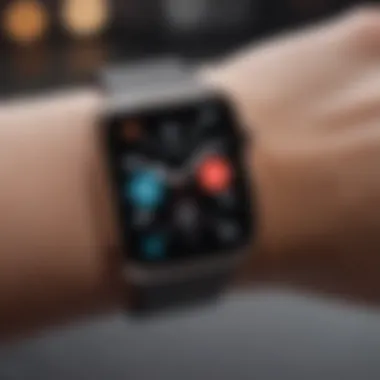

Understanding this release date is not just an exercise in predicting product updates. It’s a window into Apple’s strategic planning, consumer psychology, and competitive positioning in the tech landscape.
Market Positioning of the New Apple Watch
Understanding the market positioning of Apple's upcoming smartwatch is crucial. It not only sheds light on Apple's product strategy but also reflects consumer expectations. Since its inception, the Apple Watch has carved its niche in the crowded wearable market. With each iteration, Apple seems to hone in on key features that resonate well with users. This section examines the strategic elements that impact the positioning of the new Apple Watch, including its target demographic and competing brands.
Target Demographic Insights
Apple’s keen eye on demographics has always played a pivotal role in shaping its products. For the new Apple Watch, the target audience can be broken down into distinct groups:
- Health enthusiasts: These individuals focus heavily on fitness tracking and health monitoring capabilities. Apple is likely to enhance health features to draw this crowd, including heart rate monitoring, sleep tracking, and possibly new metrics for activity.
- Tech-savvy consumers: People who love technology and are on the lookout for the latest gadgets are a major target. They appreciate high-end features like seamless connectivity with other Apple devices and advanced app functionalities.
- Fashion-conscious individuals: Many view smartwatches as fashion accessories. Apple has historically designed its watches to be aesthetically pleasing, and the upcoming version will likely continue this trend with customizable bands and materials.
The anticipation surrounding the Apple Watch also taps into demographic shifts such as aging populations emphasizing health and wellness, and younger generations keen on blending technology with everyday life. These disparate groups each carry differing expectations, which is where Apple has to tread carefully while innovating.
Competitive Landscape in the Smartwatch Arena
The smartwatch market is a battleground filled with contenders. Apple faces fierce competition from several brands, each with unique offerings. Understanding this landscape is essential for Apple as it positions its new watch:
- Samsung: Known for its Galaxy Watch series, Samsung challenges Apple with robust health tracking and longer battery life. Their devices often cater to Android users, which represents a sizeable market.
- Garmin: Well-regarded for fitness-oriented smartwatches, Garmin appeals to athletes. Its durability and specialized features in sports monitoring make it a strong rival.
- Fitbit: On the lower price spectrum, Fitbit focuses primarily on fitness tracking rather than more extensive smartwatch functionalities. It’s favored by those who prioritize health metrics without the added complexity of a full-fledged smartwatch.
- Google (Wear OS): While not a singular device, Google’s ecosystem presents serious competition with its focus on seamless integration with Android devices. The Wear OS platform may become increasingly attractive as it gets refined.
The competition means that Apple can’t rest on its laurels; it will necessitate constant adaptation and innovation to stay ahead in this rapidly evolving field.
In summary, the positioning of the new Apple Watch must balance appealing to its established user base while simultaneously tapping into new markets. By doing so, Apple will not only reinforce its brand loyalty among existing customers but also attract a broader audience hungry for the next big thing in wearables.
Customer Expectations and Buying Behavior
Understanding customer expectations and buying behavior is crucial when talking about the new Apple Watch. Not just because it’s a popular gadget, but also due to how these aspects shape the overall market. With tech-savvy users, discerning their preferences allows Apple to fine-tune their offerings to match consumer desires. As we can see, folks aren’t merely looking for a wristwatch; they want a lifestyle accessory that enhances their overall experience.
Price Sensitivity Factors
When it comes to the price of the Apple Watch, it’s a delicate balancing act. Many buyers keep a firm grip on their wallets, assessing what they get for their money. This becomes even more topical with every new release. If the price is sky-high, potential customers might just shrug it off or look to alternatives rather than splurge. Here are elements affecting price sensitivity:
- Economic Conditions: Broader economic factors can impact how consumers respond. During a recession, even the most loyal fans may hesitate to part with their cash.
- Competitor Pricing: Consumers keeping an eye on what others offer plays a role too. Samsung's Galaxy Watch, for instance, might coax away those on the fence.
- Feature Value: If buyers believe the watch comes loaded with new features that justify the price tag, they’re likely more willing to lay down the cash. But if they perceive it as the same old song, suddenly it seems less worth the investment.
Perceived Value and Brand Loyalty
The essence of perceived value hinges on what customers believe they are getting in return for their dollars spent. Apple has been a masterful architect of brand loyalty, turning many into fervent fans who wouldn’t think twice about purchasing the latest device, no matter the cost. Some points to consider on this subject include:
- Brand Reputation: Apple thrives on a reputation of quality and innovation. Users often feel they’re part of an exclusive club, enhancing their loyalty.
- Ecosystem Integration: Many opt for Apple products because of the seamless experience across the ecosystem. Owning an iPhone makes the Apple Watch feel like a natural addition, enhancing its perceived value.
- Social Influence: Often, the opinions of friends and family, or even influencers on social networks, can sway decisions. If someone sees a well-known influencer flaunting the latest watch, it nudges their decision closer to a purchase.
"A strong brand can often charge a premium and still churn out sales like hotcakes. Brand loyalty not only sustains, but amplifies demand."
Understanding these dynamics helps tailor marketing strategies. For Apple, waiting to pique interest right before a launch means gauging customer sentiment and adjusting their offerings to amplify perceived value. By analyzing these factors, Apple gleans insights that guide their decisions, ultimately steering the release of their next innovative gadget.
Implications for Future Apple Products
The anticipated release of the new Apple Watch extends far beyond the scope of just a new gadget. It’s a crucial segment in Apple’s broader ecosystem strategy, essentially setting the stage for what lies ahead not only in wearables but across various facets within the Apple product lineup. As we delve into this discussion, it becomes clear that the advancements and changes in the upcoming Apple Watch carry significant implications for future Apple products and services.
Integration with Other Apple Services
One of the hallmark features of the new Apple Watch is its potential for deeper integration with Apple’s existing array of services. Imagine a scenario where your smartwatch doesn't merely track fitness or alert you about notifications but serves as a central hub for your smart home, health data, and even your Apple content ecosystem.
- Apple Health and Fitness: The integration could elevate Apple Health by aggregating and analyzing data from multiple devices, offering personalized insights. For example, if your watch notes irregular breathing patterns during sleep, it might suggest a consultation with a healthcare professional via Apple’s telehealth products.
- HomeKit: With enhancements in smart home integration, users could control their home devices directly from their wrists. A quick tap can dim the lights, adjust your thermostat, or even lock the door, all while keeping your phone in your pocket.
- Apple Music and Podcasts: Streaming music or podcasts might become even more seamless, allowing users to store playlists directly on the watch or control playback not just on the watch but sync with other devices in the home.
By making its devices more interconnected, Apple can not only enhance user experience but also fortify customer loyalty. When customers own multiple Apple devices, the incentive to remain within the ecosystem grows significantly.
Potential for New Product Lines
Beyond immediate integrations, the implications of the new Apple Watch could herald the introduction of novel product lines. It represents a testing ground where innovative ideas can flourish, which Apple might later apply to other products.
- Wearables Expansion: The groundwork laid by this watch might lead to other wearable devices, such as augmented reality glasses or even more advanced health monitoring devices. The increased capabilities of wearables can encourage Apple's developers to create a whole new segment of products designed to enhance everyday living.
- Customized Accessories: As personalization continues to be a buzzword in tech, different bands or covers that complement the watch’s features may emerge. More than just aesthetics, these accessories could integrate additional functionalities, such as enhanced sensors or battery packs.
- New Software Innovations: The anticipated features might drive software updates or even new operating systems, expanding what users can do with their devices. The introduction of advanced apps could pave the way for more diverse capabilities across Apple products.
"The future of Apple’s ecosystem relies heavily on how well it can merge technology with daily life, and the new Apple Watch is just the tip of the iceberg."
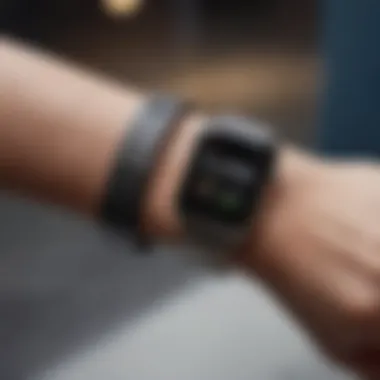

As we analyze these implications, it’s crucial to stay focused on how the upcoming Apple Watch release may play a pivotal role in advancing Apple’s long-term vision. Exploring these avenues can help Apple not only sustain but substantially grow its market presence in an industry that craves innovation.
Feedback from Industry Experts
The insights of industry experts play a pivotal role in shaping consumer expectations and influencing buying behaviors regarding Apple's new watch. These individuals often possess a wealth of knowledge and experience in technology trends, offering valuable foresight into what may soon hit the market. In this section, we will explore how insights from tech analysts and consumer reviewers contribute to the overall narrative of the anticipated release.
Insights from Technology Analysts
Technology analysts serve as the eyes and ears of the market. They analyze not just Apple’s product cycles but also broader trends impacting the smartwatch sector. Their evaluations can lay bare what features will likely resonate with users and how the new watch might stand up against competitors.
Consider, for example, the trend towards health-focused wearable technology. Analysts might highlight how the upcoming Apple Watch could introduce innovative health monitoring features, such as advanced heart rate sensors or the integration of AI for personalized fitness coaching. Such revelations might not only spark interest among health-conscious buyers but also convince skeptics of smartwatches' functional value.
Think of their comments as a weather forecast for a forthcoming storm – it shapes consumer expectations. If an analyst suggests that a feature is likely to be included based on recent patents or prototype leaks, it can create buzz and drive conversations online, allowing brands to gauge consumer interest.
Perspectives from Consumer Reviewers
Consumer reviewers add another layer to the anticipation surrounding Apple's upcoming watch. Their perspectives are often rooted in real-world experiences with previous Apple Watch models, and their feedback tends to focus on usability, design, and value.
Insights they share can expose the nuances that may not be apparent in marketing material. For instance, a reviewer might articulate the need for longer battery life based on their daily usage patterns, providing critical feedback that resonates with everyday users. Moreover, when reviewers express concerns or praise about certain features, they can sway potential buyers' opinions.
"Power user reviews often reveal both strengths and weaknesses, helping manufacturers adjust their approach before releases."
Users value other customer testimonials greatly, so they often reference these reviews to inform their purchasing decisions. A common example includes discussions on how the integration of newer apps can enhance the daily life experience or how well the design caters to multiple lifestyles. Concerns raised about comfort and functionality can lead to improvements in the subsequent iterations of the product.
To summarize, the feedback from both technology analysts and consumer reviewers is not merely supplementary; it is integral in understanding the scope and impact of Apple's new watch. Their insights not only guide prospective buyers but also shed light on how Apple can better meet consumer demands and expectations in a fiercely competitive landscape.
The Role of Social Media in Anticipation
The anticipation surrounding new products is often fuelled by social media. As platforms where news spreads like wildfire, they offer a unique breeding ground for speculation and engagement among consumers and brands. In the context of the new Apple Watch, social media enhances excitement, driving conversations and keeping potential buyers in the loop.
Influencer Marketing Dynamics
In today's digital landscape, influencers wield considerable power when it comes to shaping public perception. They have the knack for creating genuine connections with their followers which gives their opinions significant weight. For instance, tech reviewers and lifestyle influencers can showcase the potential features and capabilities of the new Apple Watch before it’s officially launched, stirring buzz and anticipation. This type of marketing, which looks more like organic conversation than traditional advertisement, can be a double-edged sword. While it can build hype effectively, it can also lead to inflated expectations.
- Authenticity Matters: Consumers are savvy. They can easily sniff out inauthentic endorsements. Thus, transparency is crucial. When a well-respected influencer genuinely believes in a product, their endorsement can be a game changer.
- Creating Buzz: The right influencer could spark a trend, leaving brands to scramble to keep up. This was visible during the launch of the iPhone 14, where strategic partnerships flourished.
Leveraging User Feedback
User feedback is another vital component of the social media puzzle. As consumers share their thoughts and experiences about previous models, Apple can gain insights into what their customers are truly looking for in the next iteration of the watch. Social media acts as a public customer feedback forum where prospective buyers voice their opinions.
This feedback loop is advantageous for both Apple and the consumer:
- Consumer Insights: Apple can analyze user comments, posts, and overall sentiment to refine product features according to real-world needs.
- Building Community: A sense of belonging elevates consumer engagement. When users feel their voices are heard, they are more inclined to stick with the brand.
"The pulse of the market can often be felt on social media, where trends emerge and fade at lightning speed. Utilizing these platforms helps brands stay relevant and connected with their audience."
Final Thoughts on the Upcoming Release
The launch of the new Apple Watch is more than just another product introduction; it represents a significant milestone in Apple's continuous journey of innovation and user engagement. With each new iteration, Apple not only refines its technology but also strengthens its brand identity. The upcoming release is poised to reinforce its status as a leader in the smartwatch market, captivating both loyal customers and potential new users.
Anticipated Impact on the Apple Brand
The anticipated impact on the Apple brand with the new watch is quite noteworthy. Traditionally, Apple has positioned itself as a leader in both technology and lifestyle enhancement. The timing of this release aligns with the increasing consumer appetite for health-focused wearables, playing directly into the ongoing trends of personal wellness and fitness tracking. This can drive brand loyalty to new heights as customers identify Apple not just as a tech company but as a vital partner in their health journeys.
Consider the following elements:
- Health and Wellness: Efforts to expand health monitoring features cater to a growing audience concerned about health metrics. When users feel that their devices contribute to a healthier lifestyle, their attachment to the brand grows.
- Integration Across Devices: Apple’s strength lies in its ecosystem. New features in the Apple Watch that integrate seamlessly with iPhones, iPads, and MacBooks deepen the user experience, making it more likely that current customers will remain committed to the brand.
- Perception Shift: A successful release can shift public perception, portraying Apple as an essential part of daily living. This narrative amplifies every new launch, turning product discussions into broader lifestyle conversations.
"Apple's innovation cycle not only evolves the technology but fortifies a loyal community that expects excellence."
Looking Toward Future Innovations
As we peer into the horizon marked by the upcoming Apple Watch release, the excitement is palpable not only for what is to come but also for the implications it has for future innovations. Tech enthusiasts are already buzzing about potential features like advanced biometric sensors, possibly hinting at Apple's commitment to revolutionizing personal health technology.
Key considerations when looking toward future innovations include:
- Sustainability Efforts: Apple has been vocal about its environmental commitment. New models might showcase advancements in sustainable materials or energy-efficient processes that resonate with eco-conscious consumers.
- Augmented Reality Integration: There are whispers about the incorporation of augmented reality elements within the watch, expanding the functionality beyond traditional use cases. This could alter the way users interact with both their watch and their surroundings.
- Software Ecosystem Growth: With each hardware release, software capabilities expand. New features and apps designed specifically for the new Apple Watch could set a new standard in the wearable tech sector, drawing in users who are eager to expand their digital experience.
In concluding thoughts, the forthcoming Apple Watch holds significant promise not just for immediate technological advancements but also for longer-term brand positioning and innovation trajectory. Understanding these layers adds depth to the anticipation surrounding the launch, making it a pivotal discussion point among tech aficionados.

